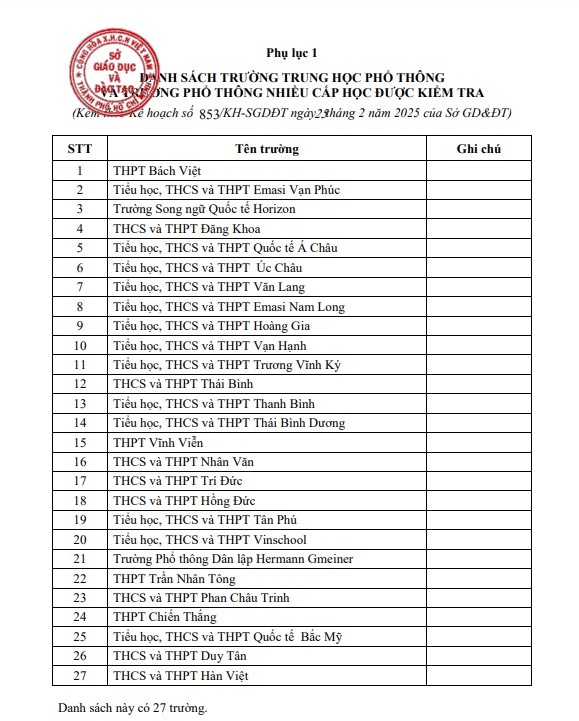What is the inspection of physical facilities at 27 non-public schools in Ho Chi Minh City about? What are the basic physical facilities required for lower secondary schools in Vietnam?
What is the inspection of physical facilities at 27 non-public schools in Ho Chi Minh City about?
Recently, the Department of Education and Training of Ho Chi Minh City issued Plan 853/KH-SDGDT in 2025...Download on the inspection of physical facilities and teaching equipment at 27 non-public schools within the city.
This inspection aims to prepare for the 2025-2026 school year and serve as a basis for assigning enrollment targets for first grades of educational levels.
Below is the list of 27 non-public schools in Ho Chi Minh City whose physical facilities will be inspected:

List of upper secondary schools and multi-level non-public upper secondary schools to be inspected
Matters to be inspected
- physical facilities and equipment:
+ Inspect the current state and investment plans for physical facilities and teaching equipment for the 2025-2026 school year and subsequent years.
+ Review documentary evidence regarding land use rights, premises, and other documents related to facility conditions.
+ Assess the procurement of equipment to implement the 2018 General Education Program.
- Other related matters:
+ Implement the payment of tuition fee support for students according to the Resolutions of the city's People's Council for the correct subjects and levels, ensuring conformity.
+ Implement the declaration of educational service prices and the results of enrollment for the 2024-2025 school year.
+ Check fire safety, mandatory fire insurance, and quality certification of constructions.
The inspection plan will be carried out over 15 days, from March 5, 2025, to March 20, 2025.
(2) Purpose
- Ensure that schools meet the facility conditions to effectively implement the education program.
- Assess the current state to assign initial enrollment targets for the 2025-2026 school year and future years.
- Detect mistakes and limitations to promptly rectify them, without affecting the normal operation of schools.

What is the inspection of physical facilities at 27 non-public schools in Ho Chi Minh City about? (Image from the Internet)
What are the general requirements regarding physical facilities for lower and upper secondary schools in Vietnam?
According to Article 40 of the lower secondary school, upper secondary school and multi-level school charter issued with Circular 32/2020/TT-BGDDT, the requirements regarding physical facilities for secondary schools in Vietnam are as follows:
Physical facilities of secondary schools
1. Technical infrastructure and physical facilities of secondary schools must meet the minimum standards for secondary school physical facilities provided for by the Ministry of Education and Training.
2. Schools shall formulate and propose specific plans and roadmaps for investment in additional physical facilities with the aim of meeting higher physical facilities standards to competent authorities for approval.
3. Schools shall manage and use their physical facilities effectively, avoiding wastage; and have plans for periodical physical facilities upgrade according to regulations; and shall not use physical facilities past their service life or physical facilities not meeting safety requirements unless upgraded or repaired.
Thus, the general requirements regarding physical facilities for lower and upper secondary schools in Vietnam are:
- Technical infrastructure and physical facilities of secondary schools must meet the minimum standards for secondary school physical facilities provided for by the Ministry of Education and Training.
- Schools shall formulate and propose specific plans and roadmaps for investment in additional physical facilities with the aim of meeting higher physical facilities standards to competent authorities for approval.
- Schools shall manage and use their physical facilities effectively, avoiding wastage; and have plans for periodical physical facilities upgrade according to regulations; and shall not use physical facilities past their service life or physical facilities not meeting safety requirements unless upgraded or repaired.
What are the basic physical facilities required for lower secondary schools in Vietnam?
According to Article 14 of the standard physical facilities of preschools, primary schools, lower secondary schools, upper secondary schools and multi-level schools issued with Circular 13/2020/TT-BGDDT (amended by Article 1 of Circular 23/2024/TT-BGDDT), the basic physical facilities required for lower secondary schools in Vietnam are:
1. Administration rooms
- Principal room: has adequate working space, office equipment and devices according to applicable regulations and law;
- Vice principal room: has office equipment and devices according to applicable regulations and law;
- School office: at least 1; has adequate office equipment and devices according to applicable regulations and law;
- Security room: at least 1; situated near entrance of the school with good visibility;
- Sanitary areas for teachers, officials and employees: situated along functional rooms and separated by gender; number of equipment: 15 males/urinal stand, 20 males/toilet bowl, 1 wash-basin/4 toilet bowls but no less than 1; 15 females/toilet bowl, 1 wash-basin/2 toilet bowls but no less than 1. In case of independent sanitary areas, situate in places that are convenient for use and do not affect the environment;
- Parking lot for teachers, officials and employees: has roof and adequate parking spaces.
2. Studying rooms
- Classrooms: ensure at least 0,6 rooms per class; fully equipped with students’ desks and chairs as per regulation; teachers’ desks and chairs; whiteboards; lighting systems according to the National Technical Regulation on lighting – permissible levels of lighting in the workplace; fan systems (air conditioners may be equipped according to actual conditions);
- Subject classrooms: at least 4 subject classrooms according to regulations of the Ministry of Education and Training of Vietnam for Music, Fine Arts, Technology, Natural Science, Informatics, Foreign Languages, Civil Education, History, and Geography. Based on the actual conditions, combine a number of subject classrooms according to the following principles: assurance of the adequate functions of subject classrooms with similar functions and sufficient devices for each subject, arrangement of time and space for teaching and educational activities by each function, and assurance of plans and teaching hour norms based on the scale of students for subjects.
3. Study assisting rooms
- Libraries: ensure the level-1 facility standard according to the standards of secondary school libraries promulgated by the Ministry of Education and Training of Vietnam;
- Education equipment room: at least 1; equipped with adequate shelves and cabinets to store and preserve teaching equipment of the school;
- Room for academic consulting and rehabilitation of student with disabilities: at least 1; situated at the 1st storey;
- Tradition room: at least 1; fully equipped;
- Room for unions and associations: at least 1; fully equipped with equipment; maybe integrated with tradition room.
4. Auxiliary rooms
- Meeting room for the entire officials, teachers and staff of the school: at least 1; fully equipped as per the law;
- Room for specialized teams: at least 1 room shared by all specialized teams; in schools with more than 30 classes: at least 2 rooms; fully equipped as per the law;
- Medical room: at least 1; medicine cabinets with essential medicines, first aid equipment and hospital beds;
- Storage: at least 1; to store general equipment and school supplies;
- Student parking lot: installed with roof; parking space for students with disabilities are located near the entrance;
- Student sanitary areas: situated along functional rooms; separated by gender; guaranteed accessibility for students with disability; number of equipment: 1 urinal stand, 1 toilet bowl and 1 wash-basin for every 30 boys (in case of urinal trenches, 0.6 m in length for every 30 boys) with walls/partitions separating urinal stands from toilet bowls; 1 toilet bowl and 1 wash-basin for every 20 girls. In case of separate sanitary areas, situate in location that is convenient and not affecting the environment;
- Gates and fences: school and school cluster premises must be separated from the outside by sturdy and safe fences (walls or trees); gates of schools and school clusters must be reinforced and firm to hold school name signs.
5. Playgrounds and sports fields
- At least 1 general space for school activities; flat surface with shade provided by trees;
- Sports fields must be safe and equipped with tools and equipment for students.
6. General activity rooms
- Kitchens (for schools organizing cooking): independent of studying rooms and study assisting rooms; one-piece flow manner; hygienic;
- Kitchen storage (for schools organizing cooking): separates storage of raw food and cooked food; installed with independent and convenient product input and output routes and separated for each type of food; equipped with food preservation equipment;
- Dining halls (for boarding schools): fully equipped to serve students;
- Dormitory (for boarding schools): installed with adequate bedrooms, sanitary and shower rooms for students; separated by gender; fully equipped;
- Student administration rooms (for boarding schools): situate dormitories for teachers managing boarding students;
- General room (for boarding schools): situated in boarding area, near student dormitories; fully equipped.
7. Technical infrastructure
- Clean water supply: meets use demand, water quality regulation and standards according to applicable regulations and law; water drainage system, sewer combining with covered trenches and wastewater treatment system satisfy wastewater quality as per the law before discharging into the environment;
- Power supply system: meets capacity and safety requirements to serve school’s operations;
- Fire prevention system: complies with applicable regulations and law;
- Information, technology and communication infrastructure: phone and internet connection serving school’s operations;
- Garbage collection areas: situated independently, away from functional rooms and at the end of the wind; installed with separate entrance convenient for collecting and transporting garbage; installed with separate water drainage system and no affecting the environment. Separate collection of toxic chemicals and experiment waste.
8. Work items specified in 1, 2, 3, 4, 5, and 6 shall be reinforced structures or semi-reinforced structures. Reinforced structures must not account for less than 40%.
9. Teaching equipment
- Teaching equipment must be guaranteed according to regulations of Ministry of Education and Training;
- Classrooms for specific subjects must be equipped with tables, chairs, cabinets, shelves, stands, electrical and water systems, fan and ventilation systems, other auxiliary devices, teaching equipment and study materials depending on each subject.

